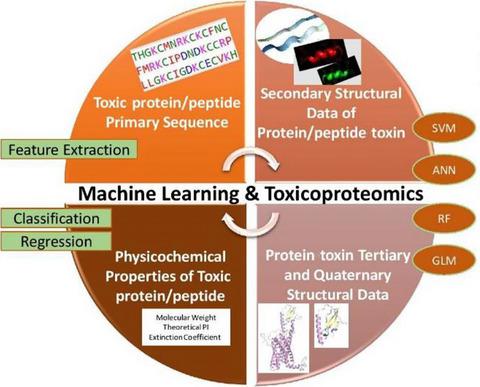当前位置:
X-MOL 学术
›
Chem. Bio. Drug Des.
›
论文详情
Our official English website, www.x-mol.net, welcomes your
feedback! (Note: you will need to create a separate account there.)
Artificial intelligence and machine learning for protein toxicity prediction using proteomics data
Chemical Biology & Drug Design ( IF 3.2 ) Pub Date : 2020-10-15 , DOI: 10.1111/cbdd.13701 Shubham Vishnoi 1 , Himani Matre 2 , Prabha Garg 3 , Shubham Kumar Pandey 3
Chemical Biology & Drug Design ( IF 3.2 ) Pub Date : 2020-10-15 , DOI: 10.1111/cbdd.13701 Shubham Vishnoi 1 , Himani Matre 2 , Prabha Garg 3 , Shubham Kumar Pandey 3
Affiliation

|
Instead of only focusing on the targeted drug delivery system, researchers have a great interest in developing peptide‐based therapies for the procurement of numerous class of diseases. The main idea behind this is to anchor the properties of the receptor to design peptide‐based therapeutics. As these macromolecules have distinct physicochemical properties over small molecules, it becomes an obligatory field for the treatment of diseases. For this, various in silico models have been developed to speculate the proteins by virtue of the application of machine learning and artificial intelligence. By analysing the properties and structural alert of toxic proteins, researchers aim to dissert some of the mechanisms of protein toxicity from which therapeutic insights may be drawn. Numerous models already exist worldwide emphasizing themselves as leading paramount for toxicity prediction in protein macromolecules. Few of them comparatively compete with the other predictive protein toxicity models and convincingly give a high‐performance result in terms of accuracy. But their foundation is quite ambiguous, and varying approaches are found at the level of toxicoproteomic data utilization while building a machine learning model. In this review work, we present the contribution of artificial intelligence and machine learning approaches in prediction of protein toxicity using proteomics data.
中文翻译:

利用蛋白质组学数据进行蛋白质毒性预测的人工智能和机器学习
研究人员不仅专注于靶向药物递送系统,还对开发用于采购多种疾病的基于肽的疗法非常感兴趣。其背后的主要思想是锚定受体的特性,以设计基于肽的疗法。由于这些大分子相对于小分子具有独特的理化特性,因此成为治疗疾病的必不可少的领域。为此,已经开发了各种计算机模型,以借助机器学习和人工智能来推测蛋白质。通过分析毒性蛋白质的特性和结构警报,研究人员旨在探讨蛋白质毒性的一些机制,从中可以得出治疗学的见解。全世界已经存在许多模型,这些模型强调它们本身是预测蛋白大分子毒性的首要条件。他们中很少有人能够与其他预测性蛋白质毒性模型进行比较,并且令人信服地在准确性方面给出了高性能的结果。但是它们的基础是模棱两可的,在建立机器学习模型的同时,在毒物学数据利用方面发现了各种方法。在这项审查工作中,我们介绍了使用蛋白质组学数据预测蛋白质毒性的人工智能和机器学习方法的贡献。但是它们的基础是模棱两可的,在建立机器学习模型的同时,在毒物学数据利用方面发现了各种方法。在这项审查工作中,我们介绍了使用蛋白质组学数据预测蛋白质毒性的人工智能和机器学习方法的贡献。但是它们的基础是模棱两可的,在建立机器学习模型的同时,在毒物学数据利用方面发现了各种方法。在这项审查工作中,我们介绍了使用蛋白质组学数据预测蛋白质毒性的人工智能和机器学习方法的贡献。
更新日期:2020-10-16
中文翻译:

利用蛋白质组学数据进行蛋白质毒性预测的人工智能和机器学习
研究人员不仅专注于靶向药物递送系统,还对开发用于采购多种疾病的基于肽的疗法非常感兴趣。其背后的主要思想是锚定受体的特性,以设计基于肽的疗法。由于这些大分子相对于小分子具有独特的理化特性,因此成为治疗疾病的必不可少的领域。为此,已经开发了各种计算机模型,以借助机器学习和人工智能来推测蛋白质。通过分析毒性蛋白质的特性和结构警报,研究人员旨在探讨蛋白质毒性的一些机制,从中可以得出治疗学的见解。全世界已经存在许多模型,这些模型强调它们本身是预测蛋白大分子毒性的首要条件。他们中很少有人能够与其他预测性蛋白质毒性模型进行比较,并且令人信服地在准确性方面给出了高性能的结果。但是它们的基础是模棱两可的,在建立机器学习模型的同时,在毒物学数据利用方面发现了各种方法。在这项审查工作中,我们介绍了使用蛋白质组学数据预测蛋白质毒性的人工智能和机器学习方法的贡献。但是它们的基础是模棱两可的,在建立机器学习模型的同时,在毒物学数据利用方面发现了各种方法。在这项审查工作中,我们介绍了使用蛋白质组学数据预测蛋白质毒性的人工智能和机器学习方法的贡献。但是它们的基础是模棱两可的,在建立机器学习模型的同时,在毒物学数据利用方面发现了各种方法。在这项审查工作中,我们介绍了使用蛋白质组学数据预测蛋白质毒性的人工智能和机器学习方法的贡献。











































 京公网安备 11010802027423号
京公网安备 11010802027423号